Today, French actress Michèle Morgan (1920-2016) has died. The classic blonde beauty has been one of her country's most popular leading ladies for over five decades. The delicate, sophisticated, and detached star was especially noted for her large, expressive eyes. Tomorrow follows part two of this post.

French postcard by Greff S.E.R.P. Editeur, Paris, no. 4. Photo: Studio Harcourt.

French postcard by Editions P.I., no. 71. Photo: Studio Piaz.

French postcard by Edit. Chantal, Rueil, no. 571. Photo: Discina, Paris.

French postcard by Edit. Chantal, Rueil, no. 571 (?).
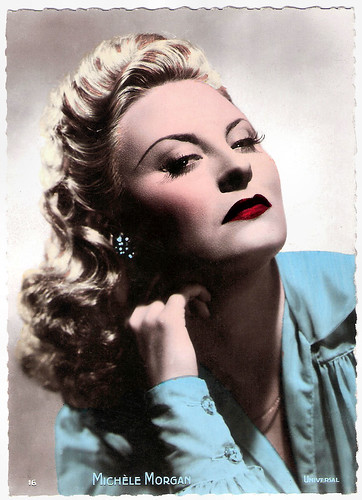
French postcard by Editions P.I., Paris, no. 16. Photo: Universal.

French postcard by Editions P.I., La Garenne-Colombes, no. 133. Photo: GIBE.
Michèle Morgan was born as Simone Renée Roussel in 1920 in Neuilly-sur-Seine, France. Michèle has three younger brothers. Her father was a departmental head in an export house of fragrances. After the crisis of 1929, he found himself unemployed and relocated the family from the wealthy Parisian suburb of Neuilly-sur-Seine to Dieppe in Upper Normandy.
It was at the Dieppe Casino that Michèle began to attend stage shows and became enamoured with the idea of acting. At 15, she left home with her younger brother Paul, to pursue an acting career in Paris. There, she began her career working as an extra. Through a casting agency, she won a bit role in Mademoiselle Mozart / Meet Miss Mozart (Yvan Noé, 1935) starring Danielle Darrieux.
The film's director, Yvan Noé, suggested she perfect her acting technique by taking lessons. With her salary for small roles in films like Une fille à papa / A Daughter for Father (René Guissart, 1935) with Josette Day, she paid for drama classes. Morgan studied acting under René Simon and chose the pseudonym of Michèle Morgan, taking it from the Morgan Bank in Paris.
She was soon noticed by director Marc Allégret, who offered her a major role in the comedy Gribouille (1937), opposite the great French actor Raimu. Then came Orage (Marc Allégret, 1938) with Charles Boyer, the classic romantic crime drama Le Quai des brumes / Port of Shadows (Marcel Carné, 1938) opposite Jean Gabin and Michel Simon, and Remorques (Jean Grémillon, 1941) again opposite Jean Gabin.
These films established Michèle Morgan as one of the leading actresses of the time in French cinema. Gary Brumburgh at IMDb: "Her remote, enigmatic features and gloomy allure had audiences comparing her to a young Greta Garbo."
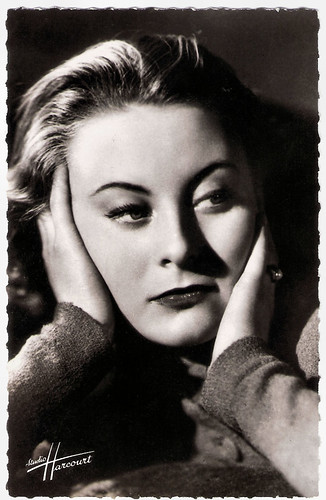
French postcard by Editions O.P., Paris, no. 5. Photo: Studio Harcourt.
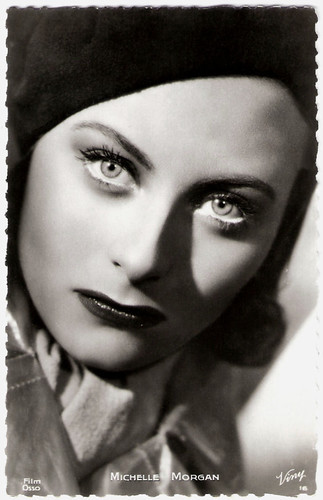
French postcard by Viny, no. 16. Photo: Film Osso. Publicity still for Marcel Carné's classic film Quai des brûmes / Port of Shadows (1938).

French postcard by Editions La Malibran, Paris / Saint Dié, no. CF 49. Photo: Eugen Schüfftan / Louis Page. Jean Gabin and Michèle Morgan in Le Quai des Brumes / Port of Shadows (Marcel Carné, 1938).

French postcard by Viny, no. 29. Photo: Star.

French postcard by Edition Ross, no. F15. Photo: Intran-Studio.

French postcard by Edition Ross, no. F17. Photo: Intran-Studio. Collection: Marlène Pilaete.
Upon the invasion of France in 1940 by the Germans, Michèle Morgan left for the United States. However, she had already been offered her contract with RKO before the start of WW2. She married American actor/singer William Marshall in 1942. Their son Mike Marshall (1944-2005) later became an actor in both France and Hollywood.
Morgan started to work for RKO. She was considered for the role of Lina in Alfred Hitchcock's Suspicion (1941), but was soon passed over since her English wasn't deemed good enough. The role went to Joan Fontaine, who won the Best Actress Oscar for her performance. Morgan then worked hard to perfect her English, and for an entire year, she saw a linguistic coach for several hours a day and improved considerably.
Morgan's first Hollywood film became Joan of Paris (Robert Stevenson, 1942), co-starring RKO leading man Paul Henreid. It would be her only American hit. Her Hollywood adventure proved to be disappointing. Gary Brumburgh at IMDb: "Her eventual move to Hollywood was based purely on her European prestige, but she did not stand out among the other female foreign imports of that time, such as Ingrid Bergman."
Nothing major came her way apart from rather routine sultry roles amid WWII surroundings. A disaster was her part in the musical Higher and Higher (Tim Whelan, 1943), starring Jack Haley and Frank Sinatra. Morgan had no prior singing experience and was supposed to take a few lessons as quickly as possible.
Morgan was considered for the role of Ilsa Lund in Casablanca (Michael Curtiz, 1942), but her studio, RKO, wouldn't release her for the amount of money Warner Bros was offering, and Ingrid Bergman was cast instead. Later, she did make with director Curtiz and Humphrey Bogart the film Passage to Marseille (Michael Curtiz, 1944), but it was far less successful than Casablanca. Her last American film was the Film Noir The Chase (Arthur Ripley, 1946), based on a novel by Cornell Woolrich and starring Robert Cummings.
After the so-so reception for her American films, Michèle Morgan returned to France. In her autobiography 'Avec ces yeux-là' (With Those Eyes, 1977), she tells an ominous anecdote about her house in Hollywood. She had a house built at 10050 Cielo Drive, slightly isolated from the other star mansions. Michèle was scared at the thought of staying alone at the place and claimed that she often heard sinister noises. She decided to move in with her new husband, William Marshall. In 1969, the house became the site of Sharon Tate's murder by the followers of Charles Manson.

Italian postcard by Rizzoli & C., Milano, 1940. Photo: Colosseum Film.
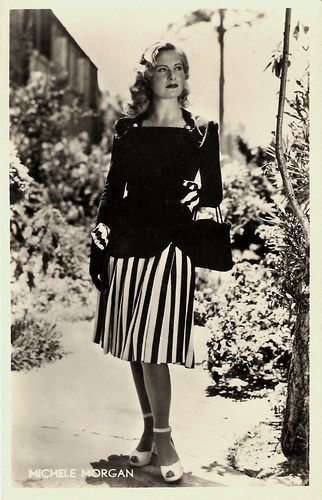
Dutch postcard by S. & v. H. A. Photo: M.P.E.A.
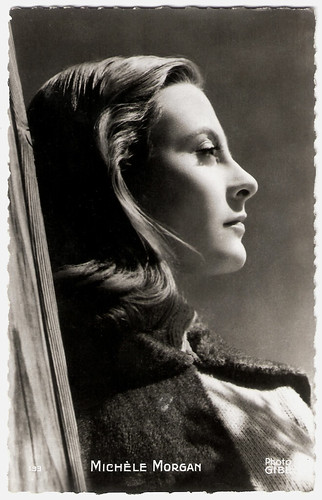
French postcard by Editions P.I., La Garenne-Colombes, no. 133. Photo: GIBE.

French postcard by Editions P.I., Paris, no. 208. Photo: Universal.

Dutch postcard by Takken, Utrecht, no. AX 1939.
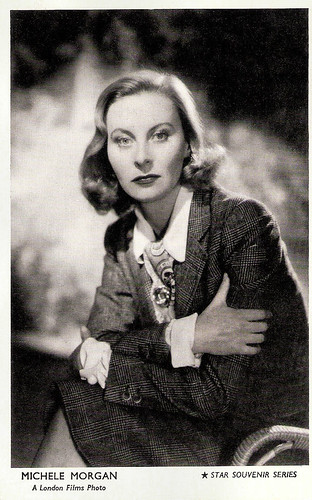
British postcard in the Star Souvenir Series by Jarrold and Sons, Ltd, Norwich, no. 61. Photo: London Films. Publicity still for Maria Chapdelaine (Marc Allégret, 1950).
At home in France, Michèle Morgan was treated much better than in Hollywood. She received the Best Actress award at the Cannes Film Festival for her touching performance as the blind heroine in La symphonie pastorale (Jean Delannoy, 1946) with Pierre Blanchar. She then appeared in the British thriller The Fallen Idol (Carol Reed, 1948) opposite Ralph Richardson.
Next, she moved to Italy for Fabiola (Alessandro Blasetti, 1949). After several years of wartime austerity, the Italian film industry returned to the Peplum, the sand and sandals spectacle. Morgan played the title role, the daughter of a Roman aristocrat (Michel Simon), during the takeover by Emperor Constantine. As a reaction to Constantine's Christian conversion policy, many old-line Romans are persecuting the city's Christian community, killing the believers off before Constantine marches into town. Fabiola is loyal to her Christian-sympathising father but is irresistibly drawn to a Roman gladiator (Henri Vidal).
Privately, she was also drawn to Vidal. During the shooting of the film, she secretly began a relationship with her co-star. At the time, her marriage to William Marshall was already falling to pieces. Marshall, who wished to gain custody of their son, hired some private detectives to follow Morgan's moves and eventually managed to have her photographed in bed with Henri Vidal. Morgan therefore lost custody of Mike due to adultery. In 1950, Vidal and Morgan married.
In 1950, she also appeared in Maria Chapdelaine / The Naked Heart (Marc Allegret, 1950). Adaptor and director Allegret fashioned the novel by Louis Hemon into a vehicle for his successful discovery. Morgan played a young woman whose romantic fantasies begin spilling over into actuality. The film's novelty value is its setting: a remote village in Northern Canada. Filmed simultaneously in French and English-language versions, The Naked Heart was produced independently on a tiny budget. Hal Erickson at AllMovie: "While the seams begin to show towards the end, for the most part the film works."
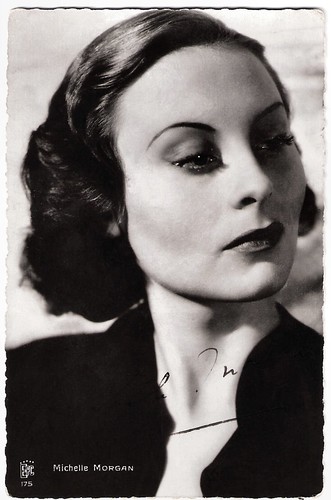
French postcard by EPC, no. 175.

French postcard by C.M.B., no. 500.

French postcard by Editions O.P., Paris, no. 112. Photo: Star.

French postcard by Editions P.I., Paris, no. 365. Photo: Sam Lévin, Paris.
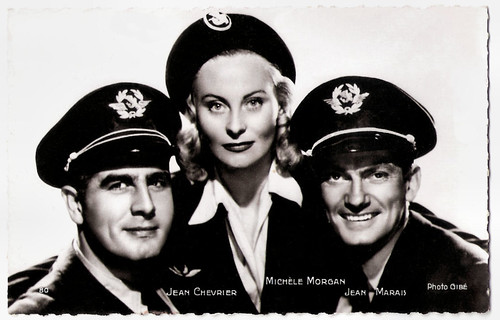
French postcard by Editions P.I., offered by Les Carbones Korès, no. 80. Photo: Qibé. Publicity still for Aux yeux du souvenir / To the Eyes of Memory (Jean Delannoy, 1948) with Jean Chevrier and Jean Marais.

French postcard in the Collection Magie Noire by Éditions Hazan, Paris, 1988, no. 6009. Photo: Sam Lévin. Jean Marais and Michèle Morgan in Aux yeux du souvenir / Nightstop in Dakar (Jean Delannoy, 1948).
Sources: Gary Brumburgh (IMDb), Hal Erickson (AllMovie - Page now defunct), Wikipedia, AllMovie, and IMDb.
This page was last updated on 31 October 2025.

French postcard by Greff S.E.R.P. Editeur, Paris, no. 4. Photo: Studio Harcourt.

French postcard by Editions P.I., no. 71. Photo: Studio Piaz.

French postcard by Edit. Chantal, Rueil, no. 571. Photo: Discina, Paris.

French postcard by Edit. Chantal, Rueil, no. 571 (?).

French postcard by Editions P.I., Paris, no. 16. Photo: Universal.

French postcard by Editions P.I., La Garenne-Colombes, no. 133. Photo: GIBE.
Gloomy allure
Michèle Morgan was born as Simone Renée Roussel in 1920 in Neuilly-sur-Seine, France. Michèle has three younger brothers. Her father was a departmental head in an export house of fragrances. After the crisis of 1929, he found himself unemployed and relocated the family from the wealthy Parisian suburb of Neuilly-sur-Seine to Dieppe in Upper Normandy.
It was at the Dieppe Casino that Michèle began to attend stage shows and became enamoured with the idea of acting. At 15, she left home with her younger brother Paul, to pursue an acting career in Paris. There, she began her career working as an extra. Through a casting agency, she won a bit role in Mademoiselle Mozart / Meet Miss Mozart (Yvan Noé, 1935) starring Danielle Darrieux.
The film's director, Yvan Noé, suggested she perfect her acting technique by taking lessons. With her salary for small roles in films like Une fille à papa / A Daughter for Father (René Guissart, 1935) with Josette Day, she paid for drama classes. Morgan studied acting under René Simon and chose the pseudonym of Michèle Morgan, taking it from the Morgan Bank in Paris.
She was soon noticed by director Marc Allégret, who offered her a major role in the comedy Gribouille (1937), opposite the great French actor Raimu. Then came Orage (Marc Allégret, 1938) with Charles Boyer, the classic romantic crime drama Le Quai des brumes / Port of Shadows (Marcel Carné, 1938) opposite Jean Gabin and Michel Simon, and Remorques (Jean Grémillon, 1941) again opposite Jean Gabin.
These films established Michèle Morgan as one of the leading actresses of the time in French cinema. Gary Brumburgh at IMDb: "Her remote, enigmatic features and gloomy allure had audiences comparing her to a young Greta Garbo."

French postcard by Editions O.P., Paris, no. 5. Photo: Studio Harcourt.

French postcard by Viny, no. 16. Photo: Film Osso. Publicity still for Marcel Carné's classic film Quai des brûmes / Port of Shadows (1938).

French postcard by Editions La Malibran, Paris / Saint Dié, no. CF 49. Photo: Eugen Schüfftan / Louis Page. Jean Gabin and Michèle Morgan in Le Quai des Brumes / Port of Shadows (Marcel Carné, 1938).

French postcard by Viny, no. 29. Photo: Star.

French postcard by Edition Ross, no. F15. Photo: Intran-Studio.

French postcard by Edition Ross, no. F17. Photo: Intran-Studio. Collection: Marlène Pilaete.
So-so reception in the USA
Upon the invasion of France in 1940 by the Germans, Michèle Morgan left for the United States. However, she had already been offered her contract with RKO before the start of WW2. She married American actor/singer William Marshall in 1942. Their son Mike Marshall (1944-2005) later became an actor in both France and Hollywood.
Morgan started to work for RKO. She was considered for the role of Lina in Alfred Hitchcock's Suspicion (1941), but was soon passed over since her English wasn't deemed good enough. The role went to Joan Fontaine, who won the Best Actress Oscar for her performance. Morgan then worked hard to perfect her English, and for an entire year, she saw a linguistic coach for several hours a day and improved considerably.
Morgan's first Hollywood film became Joan of Paris (Robert Stevenson, 1942), co-starring RKO leading man Paul Henreid. It would be her only American hit. Her Hollywood adventure proved to be disappointing. Gary Brumburgh at IMDb: "Her eventual move to Hollywood was based purely on her European prestige, but she did not stand out among the other female foreign imports of that time, such as Ingrid Bergman."
Nothing major came her way apart from rather routine sultry roles amid WWII surroundings. A disaster was her part in the musical Higher and Higher (Tim Whelan, 1943), starring Jack Haley and Frank Sinatra. Morgan had no prior singing experience and was supposed to take a few lessons as quickly as possible.
Morgan was considered for the role of Ilsa Lund in Casablanca (Michael Curtiz, 1942), but her studio, RKO, wouldn't release her for the amount of money Warner Bros was offering, and Ingrid Bergman was cast instead. Later, she did make with director Curtiz and Humphrey Bogart the film Passage to Marseille (Michael Curtiz, 1944), but it was far less successful than Casablanca. Her last American film was the Film Noir The Chase (Arthur Ripley, 1946), based on a novel by Cornell Woolrich and starring Robert Cummings.
After the so-so reception for her American films, Michèle Morgan returned to France. In her autobiography 'Avec ces yeux-là' (With Those Eyes, 1977), she tells an ominous anecdote about her house in Hollywood. She had a house built at 10050 Cielo Drive, slightly isolated from the other star mansions. Michèle was scared at the thought of staying alone at the place and claimed that she often heard sinister noises. She decided to move in with her new husband, William Marshall. In 1969, the house became the site of Sharon Tate's murder by the followers of Charles Manson.

Italian postcard by Rizzoli & C., Milano, 1940. Photo: Colosseum Film.

Dutch postcard by S. & v. H. A. Photo: M.P.E.A.

French postcard by Editions P.I., La Garenne-Colombes, no. 133. Photo: GIBE.

French postcard by Editions P.I., Paris, no. 208. Photo: Universal.

Dutch postcard by Takken, Utrecht, no. AX 1939.

British postcard in the Star Souvenir Series by Jarrold and Sons, Ltd, Norwich, no. 61. Photo: London Films. Publicity still for Maria Chapdelaine (Marc Allégret, 1950).
With those eyes
At home in France, Michèle Morgan was treated much better than in Hollywood. She received the Best Actress award at the Cannes Film Festival for her touching performance as the blind heroine in La symphonie pastorale (Jean Delannoy, 1946) with Pierre Blanchar. She then appeared in the British thriller The Fallen Idol (Carol Reed, 1948) opposite Ralph Richardson.
Next, she moved to Italy for Fabiola (Alessandro Blasetti, 1949). After several years of wartime austerity, the Italian film industry returned to the Peplum, the sand and sandals spectacle. Morgan played the title role, the daughter of a Roman aristocrat (Michel Simon), during the takeover by Emperor Constantine. As a reaction to Constantine's Christian conversion policy, many old-line Romans are persecuting the city's Christian community, killing the believers off before Constantine marches into town. Fabiola is loyal to her Christian-sympathising father but is irresistibly drawn to a Roman gladiator (Henri Vidal).
Privately, she was also drawn to Vidal. During the shooting of the film, she secretly began a relationship with her co-star. At the time, her marriage to William Marshall was already falling to pieces. Marshall, who wished to gain custody of their son, hired some private detectives to follow Morgan's moves and eventually managed to have her photographed in bed with Henri Vidal. Morgan therefore lost custody of Mike due to adultery. In 1950, Vidal and Morgan married.
In 1950, she also appeared in Maria Chapdelaine / The Naked Heart (Marc Allegret, 1950). Adaptor and director Allegret fashioned the novel by Louis Hemon into a vehicle for his successful discovery. Morgan played a young woman whose romantic fantasies begin spilling over into actuality. The film's novelty value is its setting: a remote village in Northern Canada. Filmed simultaneously in French and English-language versions, The Naked Heart was produced independently on a tiny budget. Hal Erickson at AllMovie: "While the seams begin to show towards the end, for the most part the film works."

French postcard by EPC, no. 175.

French postcard by C.M.B., no. 500.

French postcard by Editions O.P., Paris, no. 112. Photo: Star.

French postcard by Editions P.I., Paris, no. 365. Photo: Sam Lévin, Paris.

French postcard by Editions P.I., offered by Les Carbones Korès, no. 80. Photo: Qibé. Publicity still for Aux yeux du souvenir / To the Eyes of Memory (Jean Delannoy, 1948) with Jean Chevrier and Jean Marais.

French postcard in the Collection Magie Noire by Éditions Hazan, Paris, 1988, no. 6009. Photo: Sam Lévin. Jean Marais and Michèle Morgan in Aux yeux du souvenir / Nightstop in Dakar (Jean Delannoy, 1948).
To be continued tomorrow.
Sources: Gary Brumburgh (IMDb), Hal Erickson (AllMovie - Page now defunct), Wikipedia, AllMovie, and IMDb.
This page was last updated on 31 October 2025.
Happy PFF! Very interesting post - I don't recall ever seeing Michele Morgan. I'll see if I can find a copy of her movie with Bogart.
ReplyDeleteI love that you have taken the time to post all this history to match your cards. Michèle made my heart melt in Joan of Paris but I've never seen any of her other work.
ReplyDelete
ReplyDeleteStunning woman.
Thanks for the bio.
Wow, she's absolutely stunning. I've never heard of her and appreciate the in depth history.
ReplyDeleteThanks for your comments.
ReplyDeleteMichèle is gorgeous and also a talented actress. On Flickr there is even a whole group dedicated to her:
http://www.flickr.com/groups/1038492@N21/
Check it out!